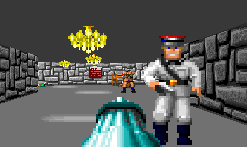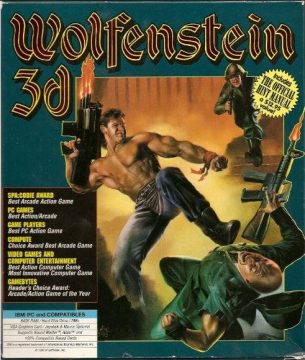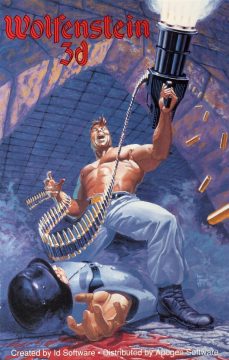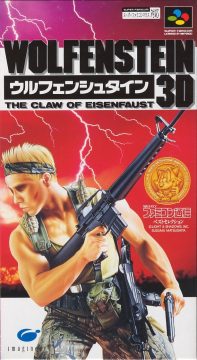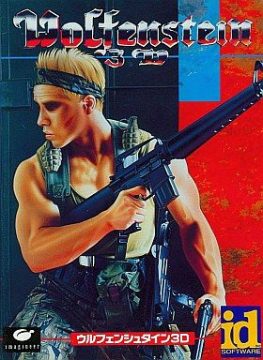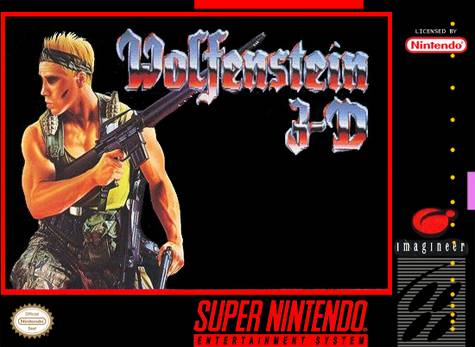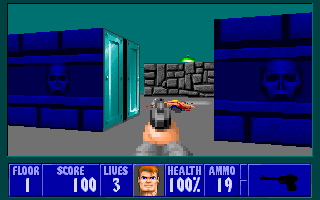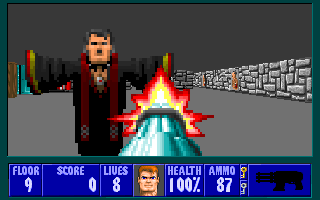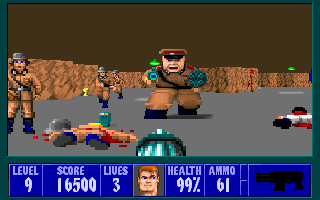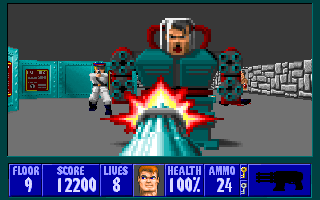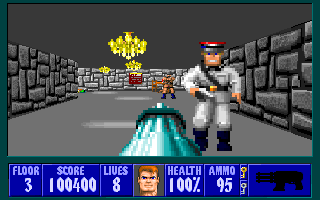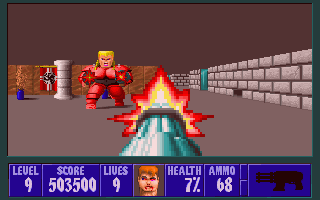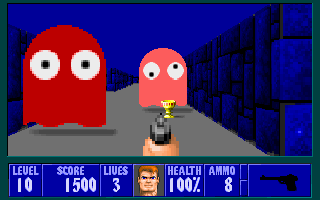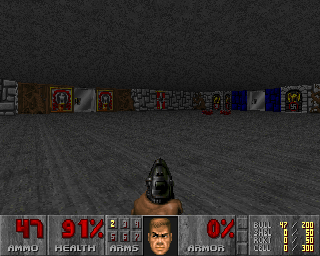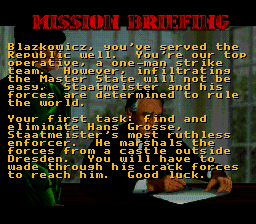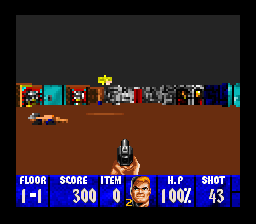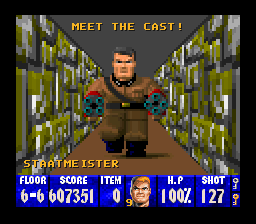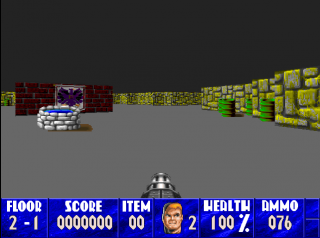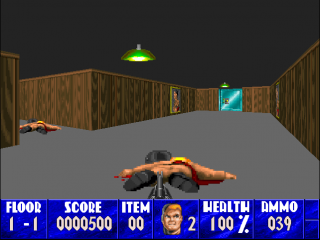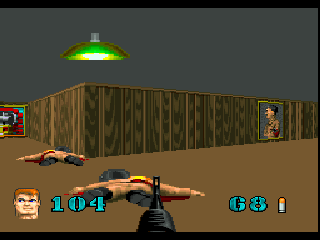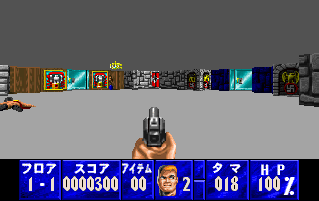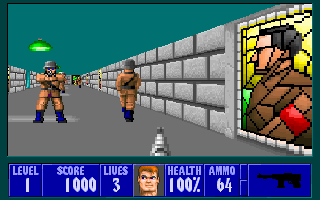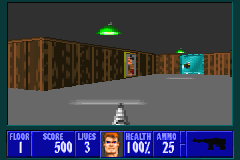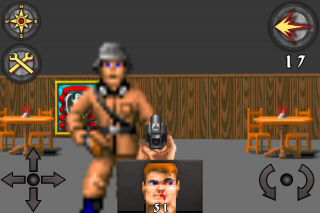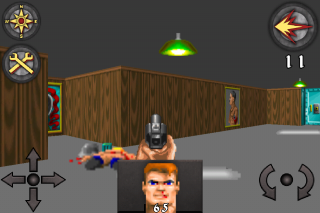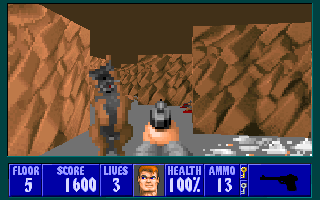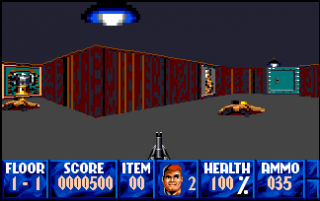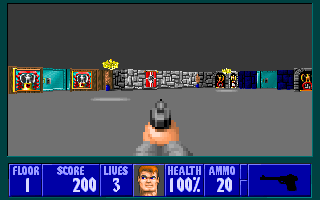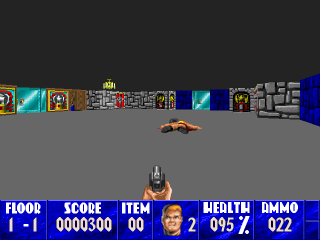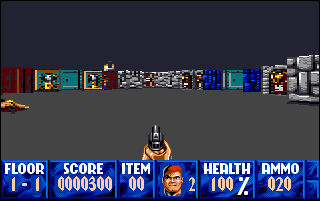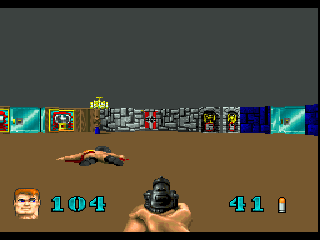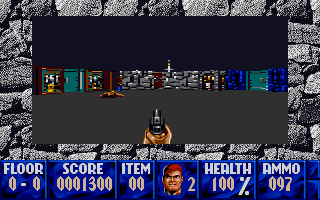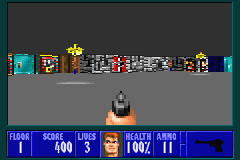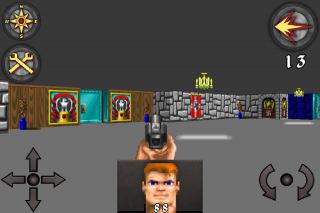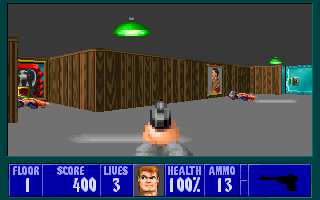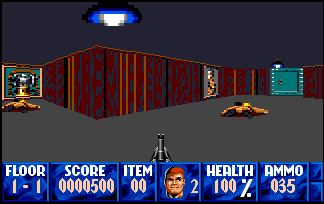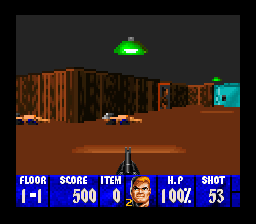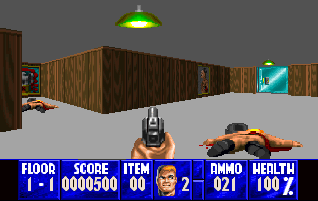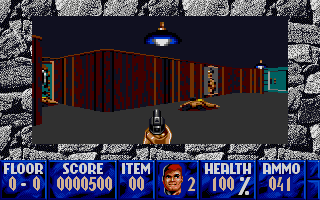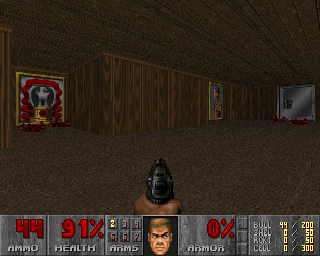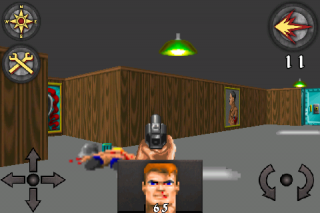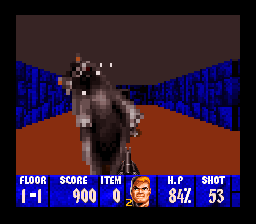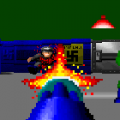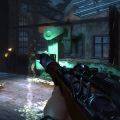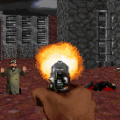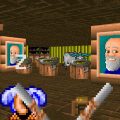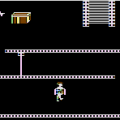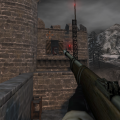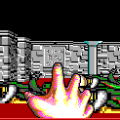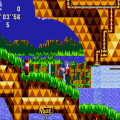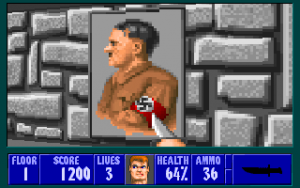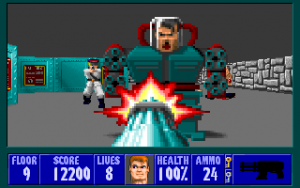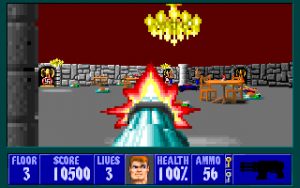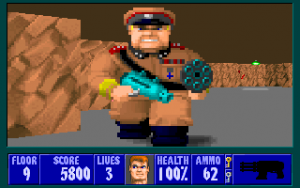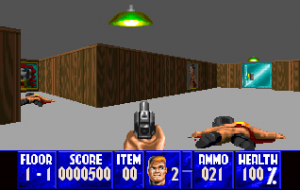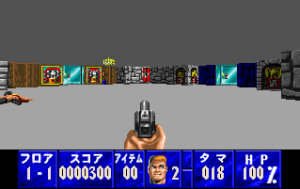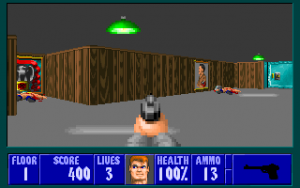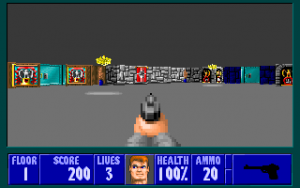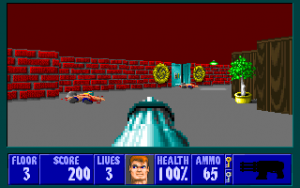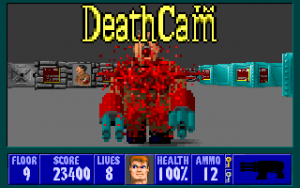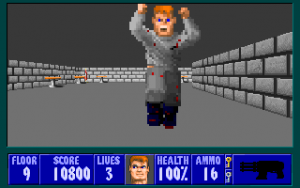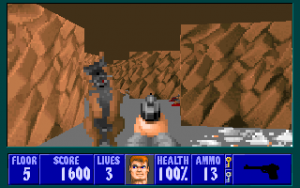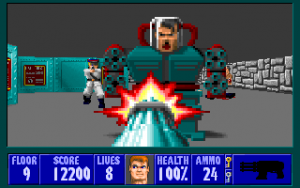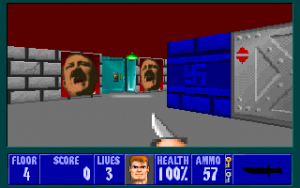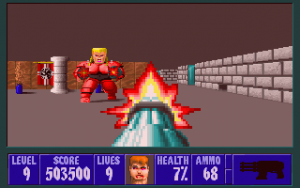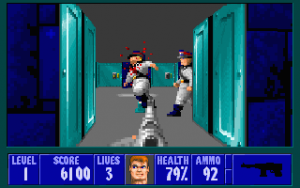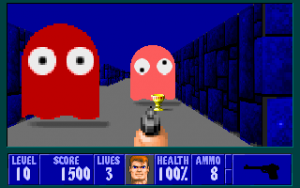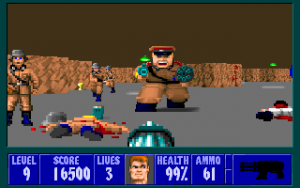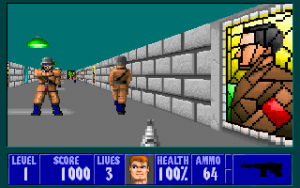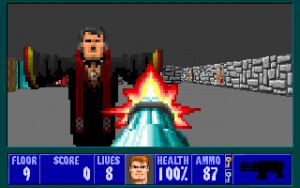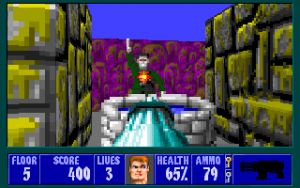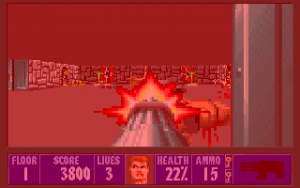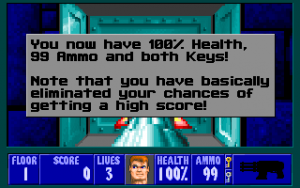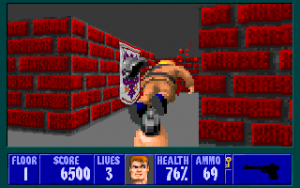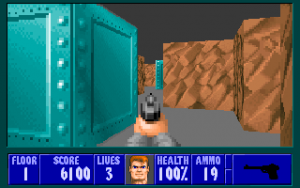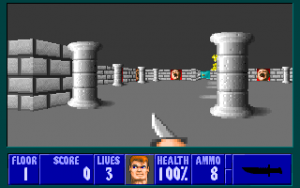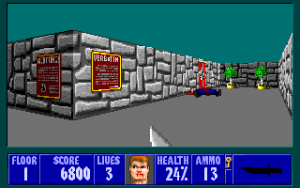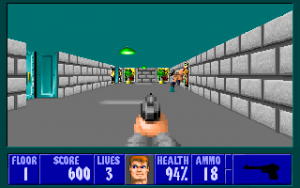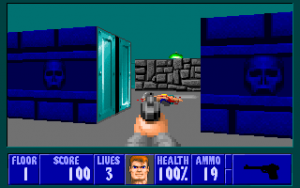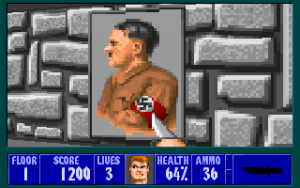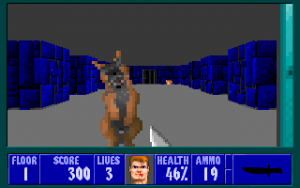Here’s the bit that the majority of gamers probably remember the most. In 1992, id Software uploaded the shareware episode of Wolfenstein 3D, entitled “Escape from Castle Wolfenstein.” The game featured full-screen textured 3D levels, using a “ray caster” engine highly optimized to run smoothly on older computers, reputedly inspired by a tech demo of Origin Systems’ Ultima Underworld that John Carmack saw at a trade show. Even in spite of the engine’s origins, this isn’t the world’s first “true” first-person shooter – Carmack’s own Hovertank 3D technically qualifies.
Wolfenstein 3D places you in the tattered prison uniform of Agent William J. “BJ” Blazkowicz, who has just been captured by the SS while attempting to infiltrate Castle Hollehammer in search of the war plans for “Operation Eisenfaust.” Unlike most FPS games, you’ll know your own face quite well, as it is displayed on the status bar, cautiously glancing from side to side and appearing increasingly bloody and bruised as you take damage. Armed with only a knife, a Luger and eight bullets, BJ must escape from Castle Wolfenstein, taking down whatever Nazis happen to get in the way.
As you fight through the castle, you’ll encounter quite a number of different types of Nazis. Much like anything else, they come in all manners of shapes, sizes, and colors – everything from the generic brown guards to the much faster white-clad officers, and the machine gun wielding SS, German Shepherds, and the dreaded Mutants, who make no sound whatsoever until they’re right up in your face rapid-firing you to death. There are also bosses, one per-episode, generally involving oversized Nazis in heavy battle armor, with two (or more) chain guns. There is also mad scientist Dr. Schabbs, who throws mutagen needles at you; Otto Giftmacher, who has a rocket launcher; and ultimately, Adolf Hitler, who first meets you in the form of a ghost-like, fireball-spewing apparition, and finally does direct battle with you from his mech suit, sporting four chain guns. For most of these bosses, killing them triggers the “DeathCam” – the action freezes, and the game says, “Let’s see that again!” Then, with the flashing “DeathCam” message at the top of the screen, you get to watch the boss go through his death throes a second time.
While many of Wolfenstein‘s gameplay conventions were nothing new to gaming in general, many of them having appeared in Carmack’s previous game, Catacomb 3-D; the presentation and sheer speed of gameplay was unprecedented. No longer were players confined to the snail’s pace of Catacomb’s wizard protagonist; players were now capable of running at breakneck speeds through the castle, clearing rooms in record time with their chain guns. It wasn’t always like this, though. It has been explained in the past, by both Carmack and Romero, that Wolfenstein 3D‘s gameplay originally took more after Silas Warner’s two Wolfenstein games on the Apple II, with players needing to spend time moving dead bodies to prevent enemies from being alerted to the player’s presence. It is unclear whose decision it was to remove these stealth elements, but the reasoning was clear enough: they slowed the game down too much. Players wanted to get in there and shoot things, not waste time dragging around dead Nazis.
Throughout the castle, there are tons of goodies such as jeweled crowns and golden goblets, as well as extra lives (your character’s face on a blue sphere) that also give you a health and ammo boost when you get them, and my personal favorite, the chain gun. These days, rapid-fire weapons are the basic weapon that you get at the start of the game, but in Wolfenstein‘s day, the chain gun was really something impressive. This was the single deadliest weapon in the entire game, eating through your maximum carry limit of 99 bullets in about 10 seconds, if you held the fire button for that long without stopping. Even the mighty blue-clad SS troopers will fall in a mere split-second if they dare to pass in front of you. The sound it makes is a glorious rapid-fire drum beat, the perfect rhythm of destruction. Its only weakness is its hunger for ammo. During boss fights you’ll be rushing to find the nearest armory. But that’s what makes the boss fights so fun. Even though every boss in the game is just a bullet sponge that can take more damage than you can do with full ammo, every boss level has stashes of ammo somewhere, and once you’ve emptied your first salvo into the boss, it turns into a hectic chase as you try to locate more ammo while they hunt you down across the level.
And let’s not forget about the single most famous boss fight in the series: Hitler himself. Sure, Bionic Commando on the NES might have predated this game by a couple of years by showing Hitler’s exploding head, but Wolfenstein ups the ante by having Hitler riding in a mecha suit, which is equipped with four chain guns and can take a massive beating at the hands of your own considerable weaponry. When you’ve finally knocked off his armor and pumped Hitler’s unarmored form full of more ordinance than the average German infantry unit uses in a week, Hitler pauses, issues forth a whimpering, “Eva, auf wiedersehen” and melts into a fine red paste, complete with a digitized slurping sound. And if you happened to miss it the first time, the DeathCam appears and shows it to you again. This ridiculous display wouldn’t be rivaled for almost 17 years, with Bionic Commando: Rearmed and its three-shot Hitler head-explosion masterpiece.
There are a lot of secrets in Wolfenstein. Most of the time, pushable walls will lead you to treasure, extra lives, and stacks of ammo or first-aid kits. But in one level per episode, one of them will lead to a secret level with extra goodies to be found. The weirdest of these can be found in Episode 3, where the secret level is a complete replica of a Pac-Man maze, complete with all four ghosts and loads of treasure to collect. True to Pac-Man convention, the ghosts cannot be killed with your weapons and will seriously injure, if not kill, you if you touch them. Episode 3 also has a sort of musical Easter egg for those who can interpret Morse code.
“TO: BIG BAD WOLF, DE: LITTLE RED RIDING HOOD. ELIMINATE HITLER. IMPERATIVE, COMPLETE MISSION WITHIN 24 HOURS, OUT.”
–Morse code from Wolfenstein 3D Episode 3, Floor 1
Much of the charm of Wolfenstein 3D, these days, lies in just how B-movie cheesy it is, compared to more contemporary games like Call of Duty: World at War. History buffs would likely call the game on inaccurate Nazi uniforms, anachronistic weaponry, and ludicrous bosses, but honestly, the funniest bit is the fact that the German spoken by all of the in-game enemies is not grammatically correct at all, due to (apparently) having been literally translated from a dictionary. While “Achtung!” and “Spion!” are convincing enough, there are the ever-present cries of “Mein leben!” (“My life!”) from dying SS men, shot officers whimpering, “Nein, so was!” (“Well, I never!”) and the first-episode boss greeting you with a hearty, “Guten tag,” (“Good day!”) before opening fire with his pair of chain guns. It is arguable that, “Mein leben!” may be one of the greatest spoken lines in all video game history, and possibly one of the best-recognized results of translation error, even up to the point where, as recently as 2009’s Wolfenstein reboot, enemy infantry still have a rare chance of screaming, “Mein leben!” when shot, and the line, “Die, Allied schweinehund!” even appears in Wolfenstein: The New Order.
When Wolfenstein 3D neared release, id Software and Apogee planned two separate contests. The first involved a maze of secret push-walls in a certain level that, when finished, ended in a hovering sign that read, “CALL APOGEE, SAY AARDWOLF.” However, crafty gamers were able to find this sign in the game data files before the contest was announced, and it had to be canceled. The other contest was a high score contest as, when an episode is completed, a special code appears next to your name on the high scores list. Calling Apogee with this code would have entered you in said contest. However, those same crafty gamers cracked this wide open as well, and the second contest was also canceled.
Wolfenstein 3D‘s had a storied history. The game engine was originally designed to run on EGA systems, but it was decided later on to switch to VGA only, to make the game look and run smoother. The color palette does still have some evidence of an EGA base, especially the fact that most in-game graphics and textures are hued in shades of blue, turquoise, or purple. Another aspect of development came up when it was decided that, out of respect for copyrights, the game shouldn’t necessarily be called Wolfenstein. According to the official hint book (and later, the official Apogee FAQ), a few of the wackier suggested working titles included: Castle Ochtenstein, Luger’s Run, The Fourth Reich, Adolph’s Bane, Hard Cell, Luger Me Now, Tank You Very Much, Castle Hasselhoff, and How Do You Duseldorf? Eventually, though, the team met with Silas Warner and asked permission to use the Wolfenstein name.
The success of Wolfenstein‘s marketing had to do with its distribution method. Players could download the entire first episode – 10 levels – from their local BBS, with the other five episodes sold as two separate trilogies. The first of these, The Original Missions, consisted of Escape from Castle Wolfenstein, Operation Eisenfaust, and Die, Fuhrer, Die! The second trilogy, The Nocturnal Missions, contained A Dark Secret, Trail of the Madman, and Confrontation. These two trilogies could be purchased separately, or together for a small discount. The fact that the shareware episode contained one-sixth of the complete game, roughly a few hours to complete for a new player, is practically unheard of in today’s game industry, where demos of new games barely last 15 minutes and rarely contain more than half of a larger level. Also, the shareware episode could fit perfectly on a single 5.25″ floppy disk, bringing meaning to “shareware,” as players could spread word of the game by literally giving copies of it to their friends. Not long after the game’s release, Apogee Software began to sell it exclusively as a complete six-episode compilation, with the trilogy versions no longer available.
id Software paid tribute to Wolfenstein 3D in Doom II: Hell on Earth, whose pair of secret levels are almost carbon copies of the game’s first level, and Hans Grosse’s boss arena. The twist, though, is that instead of Hans, you have to fight a Cyberdemon, and to finish the level, you are forced to kill four hanging Commander Keens to open the exit button. And instead of fighting the usual zombies and demons for most of the level, the SS trooper appears…and isn’t very menacing at all (though he does still cry “Mein leben!” when he dies). I guess the apparent power level of a soldier with a machine gun is somewhat lesser when you can fight back with rockets and plasma. The secret levels remain in Doom 3: BFG Edition version of Doom II, though they have been renamed to “IDKFA” and “KEEN” instead of “Wolfenstein” and “Grosse,” respectively, the music reverted to non-Wolfenstein tracks, and the SS troopers have been replaced with ordinary zombie men.
Wolfenstein is perhaps most infamous for having been banned in Germany for several reasons. The Federal Examination Office for Youth-Endangering Publications/Media (BPjM) placed Wolfenstein 3D on its “Index” in 1994 due to excessive violence. Under normal circumstances, when a game is “indexed,” this means that it cannot be advertised or displayed on store shelves, and must be kept “behind the counter.” In Wolfenstein‘s case, however, the game could still not be legally purchased, due to a German federal law that forbids using “characteristics of unconstitutional organizations,” – in other words, Nazi imagery such as swastikas and portraits of Adolf Hitler, and the game’s opening theme, an Adlib-powered rendition of the Nazi Party anthem, “Horst Wessel Lied.” While it was not illegal to own a copy of the game or download it from a BBS, it was certainly illegal to sell it, so many German fans of Wolfenstein took to referring to the game by a codename, “Hundefelsen 4C,” so that they could continue distributing copies among themselves.
Wolfenstein 3D had a successful legacy with numerous ports, both official and unofficial. The first official port was for Super Nintendo, and was developed in-house by id Software. Imagineer, the SNES version’s publisher, had originally hired another contractor to develop the port, but nine months passed and the contractor could not be contacted, forcing id Software to stop all work on their current project, Doom, and develop it by themselves, from scratch, in only three weeks. The SNES port has mostly new levels and two new weapons, a flamethrower and a rocket launcher. The 30 levels are somewhat less detailed than the PC version’s, with fewer decorations and smaller rooms, and only a small handful of them bear resemblance to levels from the PC version. Some playability changes were also made. There is no score display, but treasures add to an “Items” counter which will award an extra life and a health boost when 50 are collected. It is now possible to circle strafe with the “L” and “R” buttons, which is impossible in the PC version since there are no separate “Strafe Left” and “Strafe Right” keys. Finally, there was an Automap added, which helps immensely for navigating the corridors, since there are fewer landmarks to go by.
However, Nintendo of America’s notorious censorship guidelines bit Wolfenstein the hardest out of any game at the time, forcing id Software to remove all Nazi references such as swastikas, remove the dogs (these were replaced with giant rats instead), remove the blood (it is now “sweat”), and further de-emphasize the Nazi aspect of the game by making all enemy guards speak English (mostly just “Halt!” and “Stop!”) and removing Hitler’s mustache (he has also been renamed to “Staatmeister Meisterstaat”). Nintendo was also somewhat notorious for censoring religious symbols; in Wolf3D, you no longer collect jeweled crosses, but generic gold scepters instead.
There is a beta floating around where these changes are only half-implemented; the swastikas are still gone, but the iron crosses remain on the walls (instead of the generic plus signs), levels are somewhat different, and Hitler is now renamed to “Hister.” Also, in the beta version, the status bar labels read, “Health,” and “Ammo”; in the final, they are changed to “H.P.” and “Shots.” This version was released in Europe with no changes (beyond those already in the US version). This version was also released in Japan and given the subtitle “The Claw of Eisenfaust”. The villain has been renamed again to Adolf Trautman, who’s been recast as a mad scientist doing experiments deep within the castle. The pre-mission briefings are gone, replaced with mission titles (in Japanese).
In general, id Software was reputedly so dissatisfied with these forced changes that they gave Christian game developer Wisdom Tree their engine, which they used to make the only American-released, commercial, unlicensed SNES cartridge ever: Super 3D Noah’s Ark. The book Masters of Doom, also mentions that the development team was so frustrated with the original contractor that they stabbed his chair with a knife.
The Macintosh port, which was alternately titled, Wolfenstein 3D: First Encounter, Second Encounter, or Third Encounter, based on whether you were playing the shareware demo, the mail-ordered full version, or the retail-boxed full version, was ported and distributed by MacPlay, a division of Interplay Productions. The Macintosh version is based on the SNES version, but restores the blood, the dogs, and most importantly, Hitler and his Nazis. The same 30 levels as the Super Nintendo version are present, as are the two new weapons and the automap feature, but the graphics and sounds have been given quite an overhaul. All graphics are now twice the size as their PC versions, with a much greater attention to detail. The sounds are of vastly higher quality, with guards now speaking proper German instead of the roughly-translated “Mein leben!” from the original game.
There is one shortcoming, though, in that the enemy sprites no longer have rotations, so enemies are always facing forward, removing the ability to sneak up behind unaware guards. Also, despite the addition of separate keys for strafing left and right, it is not possible to circle-strafe, as the controls behave oddly when both a strafing and turning key are pressed. The First Encounter (the shareware demo) includes only the first three levels, ending when first boss Hans Grosse is killed. The Second Encounter provides all 30 levels from the SNES version of the game, while The Third Encounter includes not only those, but also all 60 of the PC version’s levels in their entirety, as well as improved support for third-party level packs, like Laz Rojas’ Astrostein series. The music in the Mac port is all new, composed by Interplay’s resident musician Brian Luzietti, and has nothing to do with Bobby Prince’s original compositions – not even the Nazi anthem is present. (Random side-note: the Mac version was ported back to the PC, entitled Macenstein 3D SDL – it contains the 30-level Second Encounter episode and all of the graphic and sound improvements from the Mac version, just running in the PC version’s engine in SDL.)
The Atari Jaguar’s port was based on the Macintosh Second Encounter version, with 30 levels and the high-resolution wall tiles and enemy sprites. It was developed in-house by id Software, as a “test” to determine if the Jaguar had enough horsepower to run a Doom-like game. The Jaguar version actually contains brand new weapon sprites, obviously patterned after Doom‘s but with BJ Blazkowicz’s grey shirt sleeves instead of the Doomguy’s flesh-toned rubber gloves. It is one of the few official ports to retain Bobby Prince’s original music, slightly remixed to play on the Jaguar’s sound hardware, and the sound effects are mostly from the SNES version, though the guards have gone back to speaking German instead of English.
There are actually some major gameplay changes to this version, too. The only on-screen HUD elements are health, ammo, and keys. With no score display, treasures would have otherwise become worthless, so they now count as bonus health, allowing you a maximum of 200. The bullet weapons now fire much faster, with the MP-40 firing roughly as fast as Doom’s chaingun, and the chaingun now firing nearly twice as fast as before. Since this is based on the SNES and Mac versions, there are backpacks lying around that will allow you to hold up to 300 bullets. Also, the upgrade rule from the SNES version applies here as well: the MP-40 and Chaingun are permanent upgrades to the pistol, so you are no longer able to switch back to them (or the knife, unless you’re completely out of ammo) once you have a better gun. The Rocket Launcher and Flamethrower are both selectable by pressing the Jaguar’s Option button. The automap is still available, accessible with one of the numeric pad buttons. Finally, this is the only console-based Wolfenstein port (until the Xbox version) to have a mid-level save, accessible by pressing the numbers 1, 2, or 3 on the Jaguar’s numeric pad.
The 3DO port was developed by LogicWare and published by Interplay Productions, and was based on the Macintosh Third Encounter version, so it includes the 30 SNES/Mac levels as well as all six PC version episodes. In addition to the high-quality Mac textures, sprites, and sound effects, the 3DO port contains all new synth-orchestrated CD music by Interplay’s Brian Luzietti (who also composed for the Descent games), which outside of the title theme from the Mac version, is entirely new and specifically composed for this version. It’s probably the best version of the soundtrack for thematic purposes, even though it is missing Horst Wessel Lied (and, in all honesty, makes the game sound a bit like an ’80s action flick in the process, making it all the more awesome). This version was also released in Japan, and is the only version where the status bar labels are translated.
Wolfenstein 3D was released on NEC PC-98 in Japan by Imagineer. Since the PC-98 is basically an IBM PC with some different graphic and sound hardware, the port is pretty accurate to the PC version, and runs pretty much as smooth as can be. All the blood, swastikas, and Hitler mustaches are intact. The major difference here is that the text – even the menus – has been translated into Japanese. The “Read This!” file and mission debriefings are in Japanese as well. Much of these were cut back a little, though, especially the help file which is now only ten pages instead of the 20-some of the PC original. There is some text left untranslated, such as the messages from entering cheat codes. Interestingly, this version of the game can play the digitized sounds without having a Sound Blaster card installed (though it does support one), but without Sound Blaster, all the non-digitized sounds like item pickups revert to the bleepy PC Speaker versions. Since this is a direct PC port, there is no automap, and strafing is only controlled by the Alt key.
Most bizarrely, there was an official port of Wolfenstein 3D for the Acorn Archimedes, developed by Powerslave Software, which is more or less identical to the PC version, however it also includes an editor program and a Christmas-themed scenario. It is functionally identical to the PC version, even supporting many of the level sets developed for the PC version. However, it does seem that the music plays slightly too fast, and not even in game. This version does have a very silly introduction sequence that parodies the James Bond film intro.
The original Xbox has a mostly-accurate port of the PC version, included in the Xbox port of Return to Castle Wolfenstein. However, it is only available to players who have completed the campaign mode. The music plays at the correct speed, and the sound effects are accurate to the PC version – quite unlike the later 360/PS3 downloadable versions. In the strangest omission yet, though, the Xbox version does not have any way to run quickly. There is just no Run button, and despite analog movement, “walking” speed is the fastest possible speed in this version. Granted, enemies would be hard-pressed to catch up to you anyway, but this is still a pretty strange thing to just leave out.
The Game Boy Advance had a handful of first-person shooters designed specifically for it, like Ecks vs Sever, Dark Arena, and BackTrack, and the system certainly showed that it had the horsepower for this sort of thing, so Stalker Entertainment wrote a commercial port of Wolfenstein for the GBA, published by Bam! Entertainment. The port is actually reasonably accurate to the PC version, with all 60 original levels and the original sound effects, albeit with no in-game music. The graphics are all shrunk down to fit the screen, but the sprites and textures are pretty much the same as they’ve always been. The low resolution of the 3D renderer makes it more difficult than usual to see distant enemies. Overall, it’s not bad if you’re just itching for a portable Wolfenstein and have no other system to play it on, but there are open-source ports that would work better, especially in terms of controls (since in this version, you need to hold both L and R buttons to run), though in its favor, it is possible to circle-strafe again.
When 2009’s next-gen Wolfenstein was nearing release, Activision and Nerve Software ported Wolfenstein 3D to the Xbox 360 and Playstation 3 as a downloadable title. All 60 of the PC version’s levels are present, and the game is more or less a competent emulation of the original game, though the in-game music plays at a slower tempo than the original’s, and all of the first-aid kit pickups have had their Red Cross emblem replaced with a large red heart. This probably has something to do with the Red Cross Foundation complaining about the use of their symbol in video games around the time of this port’s release. (A similar thing was done to their port of Doom II, though in that game, the Red Cross emblems were replaced with generic medicine capsules.) In a strange sign of the times, the original shareware episode, “Escape from Castle Wolfenstein”, can only be played for one level if the game has not been purchased, whereas players of the shareware version had access to the full episode before needing to shell out their money for the other five.
Wolfenstein received an official port to iPhone, iPod, and iPad devices, written by John Carmack in his spare time and released on the iTunes App Store. This version of the game takes the most after the original PC version, with completely new menus and HUD elements, and the weapon graphics from the Mac version. The game comes in “Lite” and “Platinum” versions; the Lite version contains the whole shareware episode, and the Platinum version contains all six episodes. There are a few odd changes to this port – the heart-clad medkits remain from the 360/PS3 version, there is no Use button (doors and secret walls open automatically when you walk into them), and secret level exits do not work properly, and send you to the next normal level instead. Instead of normal level progression, you can warp to any level you wish from the starting menu, since there is no saved game system.
The graphics are relatively high-res, but are a strange mixture of PC and Mac version resources, with the wall textures and pickups from the Mac version, but the guard sprites from the PC version. It’s pretty obvious that touchscreen controls don’t really work well for a first-person shooter, even if your only real controls are looking, moving, shooting, and switching weapons, so this version has options to drag the on-screen controls wherever you want, and also sliders to control the presence and sensitivity of tilt-to-move and tilt-to-turn features. Tilt-to-turn is actually quite a bit easier to aim with than an onscreen virtual thumbstick, since you only need to steer the iPhone like a steering wheel to turn. Actual controls would be preferred, but tilt controls are serviceable enough to actually play the game. Since the game content is uncut from the PC version, the game has been delisted from some countries’ regional App Store databases, including those of Austria, Switzerland, and Germany, in regards to the presence of Nazi symbols.
The most recent official port of Wolfenstein 3D is probably the most bizarre: Wolfenstein in HTML5. Yes, Wolfenstein 3D runs in a web browser (albeit a recent one, like Firefox or Chrome). It was written by John Carmack, to commemorate the imminent release of Wolfenstein: The New Order in 2014. The port is mostly the PC version, containing the first three episodes (the “Original Missions”) but not episodes four through six. The controls are slightly altered due to most browsers reserving the Control and Alt keys; firing and strafing are now on the X and Z keys instead. Though it renders at a low resolution, the game still manages to run surprisingly smooth for not requiring any browser plugins.
As far as unofficial ports go, there are a number of surprises. There was an Amiga port for AGA-compatible systems, which is pretty much just an emulation of the PC original. The port only works properly with the shareware version’s data files, so only the first episode is accessible. It is quite a pain to get working, due to the early-alpha status of the code, and requires the presence of a few external libraries to even start it, let alone get it working. When it does work, it’s near identical to the PC version, just with no music, since it was not re-composed to play back on the Amiga’s Paula chipset.
LogicWare’s 3DO port got re-ported to Apple IIGS by Eric Sheppard and released as freeware, which is hugely impressive for the IIGS’s 2.8 MHz “Mega II” processor, since it runs quite smoothly and includes full digitized sounds. This version can still be found on Sheppard’s website. Everything is present – both the Mac and PC version levels are retained from the 3DO version. In all honesty, I do prefer this version’s choice of colors, especially in the case of the overgrown walls in Episode 2, which are now a “dead leaves” shade of brownish-orange, instead of the rest of the versions’ insistence on a shade of yellow that might remind one of vomit or Alien blood. The screen can be resized, for those who have upgraded their IIGS systems, but by default it is somewhat on the small side, so as to run smoothly on a stock IIGS. The sound effects have all been re-recorded, perhaps specifically for this version of the game – I have not heard them in any of the other ports, save for the ST port.
The PC open-source release has been ported to SDL (Simple Directmedia Layer), and conversely, to every platform that SDL supports. This means that there are 100% accurate ports of Wolfenstein 3D for the Sega Dreamcast, Sony PSP, Dingoo A320, OpenPandora, Linux, BeOS, and the Nokia S60. Since these inevitably require actual PC version data files, there are no content differences between them. An archive of Wolf4SDL’s website can be found here.
Another unofficial port, this time for the Atari ST and STe, was created by the demoscene group “The Sirius Cybernetics Corp” – it is, in turn, based on Eric Sheppard’s Apple IIGS port (making this…a port of a port of a port of a port of a port*), featuring the same graphical downgrades, the same sound effects, and almost the same selection of levels, if not for the fact that Episode 2 starts with a “prologue” level, labeled Floor 2-0 by the status bar. Bobby Prince’s music returns, if only for the opening and menu screens, and plays back from the Atari ST’s sound chip, which surprisingly doesn’t sound too terrible, but perhaps mercifully does not try to play in game. The game speed is somewhat on the slow side, but this game is intended for use on upgraded machines. For those running an out-of-box ST or STe, however, there are options to reduce the screen size or run the game in low detail mode, which is a pixel-doubled mode that helps a lot with performance. This version is free to download from www.pouet.net.
Finally, recent developments have lead to the creation of a near-PC-accurate port of Wolfenstein 3D for the Sega Genesis, complete with retooled music suited to the Genesis’ YM2612 sound chip, fully working digitized sound, and the complete shareware episode of the game. Fanboys might repeat the old slogan that “Sega does what Nintendon’t” – referring to the infamously censored Super Nintendo port – but really, the Genesis port is a huge accomplishment on its own. It receives regular updates in this Sega-16 forum thread.
*Here’s the genealogy of that sentence – PC begat SNES, SNES begat Mac, Mac begat 3DO, 3DO begat IIGS, IIGS begat STe. Five descending generations from the PC original.
Screenshot Comparisons
Censorship Comparisons
